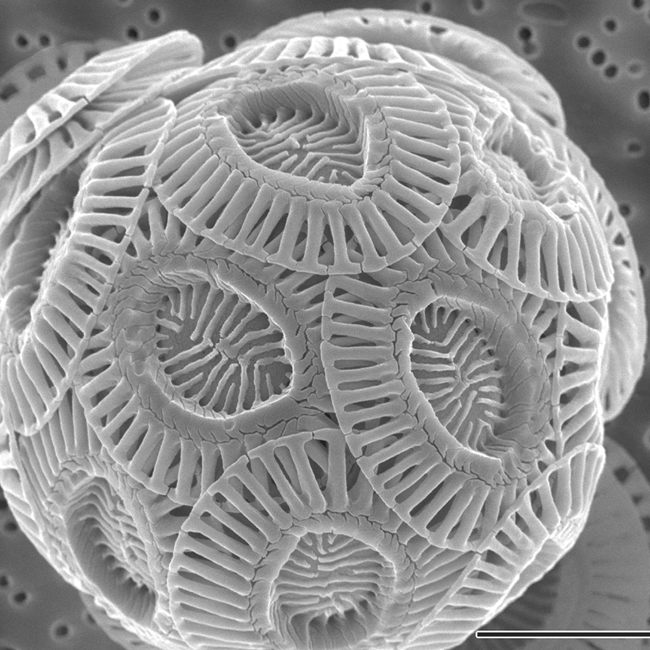The Acid Test: Armor-Covered Plankton Adapt to Warming World

Tiny armor-covered creatures that float along with the ocean's currents may adapt and survive, if badly, as their watery world warms and becomes more acidic, a new study finds.
Even so, the plankton may become flimsier and could turn into more of a "french fry" than a nutritious snack for its consumers.
As more carbon dioxide, a greenhouse gas, gets pumped into the atmosphere, and ultimately dissolves in the oceans, the seas are becoming more acidic. How this will impact life in the oceans is not known, though various studies have undertaken the challenge to find out.
In the new study, a trio of scientists at the Helmholtz Center for Oceanographic Research in Kiel, Germany, bred a variety of phytoplankton, called Emiliania huxleyi, to tolerate higher levels of carbon dioxide dissolved in the water.
They focused on these creatures for two reasons: Like other phytoplankton, E. huxleyi forms the bases of many of the ocean's food chains. In addition, this creature is a coccolithophore, which builds its shell of calcium carbonate. That shell-building can be affected by the acidity of the oceans, with more acidic oceans holding less of their shell material.
Ocean acid test
The pH of the oceans, a measure of acidity whereby lower numbers are more acidic, has changed from about 8.25 in the mid-18th century to 8.14 in 2004.
Get the world’s most fascinating discoveries delivered straight to your inbox.
To find out how this change and future changes might impact the armored plankton, researchers Kai Lohbeck, Ulf Riebesell and Thorsten Reusch took the plankton they had bred in the lab and exposed it to concentrations of carbon dioxide up to four times that in the atmosphere. They found that it can adapt, and even maintain its shell-building, though it doesn't exactly thrive. "They do less badly," Reusch said.
Their ability to adapt and survive in the "harsh" environment took less than a year (though for plankton, the time frame spans about 500 generations). Reusch said it's the first time anyone has studied the evolution of plankton over so many generations. [The Harshest Environments on Earth]
Reusch noted that the team used plankton with the same genetic makeup, so whatever changes occurred were at the level of gene expression. The particular genes that are involved will be the subject of future experiments, he said.
The team found that under higher carbon-dioxide levels, the plankton grew faster (and got bigger overall), but they didn't build shells as quickly. Compared with earlier generations, the adapted plankton did increase their rate of shell growth, but that never reached levels found under normal-CO2 conditions. Essentially, the amount of shell substance per dry weight of plankton decreased.
Ocean junk food?
Just because the plankton evolve to tolerate acidic oceans doesn't mean that the food chains won't be affected. Reusch noted that altering the water chemistry can also affect how nutritious the plankton are for the other creatures that eat them, because it affects their metabolism. "They become like french fries," he said. "The carbon-nitrogen balance becomes worse," which affects nutrients needed by those that feast on them, such as zooplankton — tiny jellyfish, copepods and shrimp.
The finding also has implications for Earth's storage of carbon. To make their shells, plankton take two bicarbonate ions from the water and make it into calcium carbonate and water, releasing an extra molecule of carbon dioxide (CO2). That means the faster they grow, the more CO2 gets pumped into the air. But the situation is more complicated, because the plankton sequester some carbon when they die, taking it with them to the bottom of the ocean. Plankton also photosynthesize, like other plants, so they release oxygen as well as removing CO2 from the air.
An expert on plankton, Larry Brand, a professor of marine biology and fisheries at the University of Miami in Florida, noted that one of the big effects of acidifying the oceans is altering the mix of creatures that live in it. If the Emiliania plankton doesn't do as well, other plants and animals will take its place. That could alter fisheries, for example. "Usually when there's a radical change in the mix of organisms, it doesn't work out too well for humans," he said.
They published their results in the journal Nature Geoscience today (April 8).



